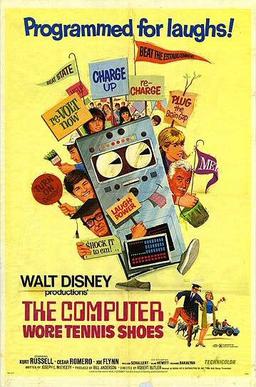The Computer Wore Tennis Shoes facts for kids
Quick facts for kids The Computer Wore Tennis Shoes |
|
|---|---|

Theatrical release poster
|
|
| Directed by | Robert Butler |
| Produced by | Bill Anderson |
| Written by | Joseph L. McEveety |
| Starring |
|
| Music by | Robert F. Brunner |
| Cinematography | Frank V. Phillips |
| Editing by | Cotton Warburton |
| Studio | Walt Disney Productions |
| Distributed by | Buena Vista Distribution |
| Release date(s) | December 31, 1969 (New Year's Eve) |
| Running time | 91 minutes |
| Country | United States |
| Language | English |
| Money made | $5.5 million (US/ Canada rentals) |
The Computer Wore Tennis Shoes is a fun American comedy film from 1969. It stars Kurt Russell, Cesar Romero, Joe Flynn, and William Schallert. This movie was made by Walt Disney Productions.
It's one of several movies Disney made that take place at Medfield College. You might have seen Medfield College in other Disney films like The Absent-Minded Professor (1961) and its sequel Son of Flubber. This movie also has two sequels, Now You See Him, Now You Don't and The Strongest Man in the World, which are also set at Medfield.
Contents
What the Movie Is About
Dexter Reilly (Kurt Russell) and his friends go to Medfield College. It's a small school that can't afford to buy a computer. The students convince a rich businessman named A.J. Arno (Cesar Romero) to give an old computer to the college.
What they don't know is that Arno secretly uses this computer for his own forbidden activities.
One day, during a big thunderstorm, Dexter is installing a new part in the computer. He gets an electric shock! This shock changes him into a "human computer."
Now, Dexter has amazing math skills. He can read and remember a whole encyclopedia in just a few minutes. He can even speak a new language perfectly after reading just one textbook!
Dexter's new abilities make him famous around the world. He becomes Medfield College's best hope to win a big TV quiz tournament. The prize is $100,000!
Dexter leads Medfield's team to win against other colleges. But during the tournament, on live TV, a special word makes Dexter accidentally say details about Arno's secret business.
Arno's helpers quickly kidnap Dexter and plan to stop him. But his friends are smart! They find the house where he is being held. They pretend to be house painters to get inside. Then, they sneak Dexter out in a large trunk.
During the escape, Dexter gets a bump on his head. This injury slowly makes his amazing mental abilities go back to normal. This happens during the final round of the tournament against Springfield State.
Luckily, one of his friends, Schuyler, is able to answer the last question. Medfield wins the $100,000 prize! Arno and his helpers try to run away from the TV studio. But they crash right into a police car and get arrested.
Meet the Cast
- Kurt Russell as Dexter Reilly
- Cesar Romero as A.J. Arno
- Joe Flynn as Dean Higgins
- William Schallert as Professor Quigley
- Alan Hewitt as Dean Collingsgood
- Richard Bakalyan as Chillie Walsh
- Debbie Paine as Annie Hannah
- Frank Webb as Pete
- Michael McGreevey as Schuyler
- Jon Provost as Bradley
- Frank Welker as Henry
- W. Alex Clarke as Myles
- Bing Russell as Angelo
- Pat Harrington as Moderator
- Fabian Dean as Little Mac
- Fritz Feld as Sigmund van Dyke
- Pete Ronoudet as Lt. Charles "Charlie" Hannah
- Hillyard Anderson as J. Reedy
- David Canary as Walski
- Robert Foul as Police desk sergeant
- Ed Begley Jr. as a Springfield State panelist
What Came Next
Sequels
- Now You See Him, Now You Don't (1972)
- The Strongest Man in the World (1975)
TV Movie Remake
This movie was made again as a TV film in 1995. It was also called The Computer Wore Tennis Shoes. In this version, Kirk Cameron played Dexter Riley.
Other Disney Channel movies, like the Not Quite Human series, had similar ideas. These movies were based on books with the same name.
Cool Opening Animation
The animated opening of the movie was created by a British artist named Alan Maley. He later won an Academy Award for his visual effects. The animation looked like early computer graphics. He made it using stop motion by moving paper cutouts a tiny bit at a time for each picture.
See also
 In Spanish: Mi cerebro es electrónico para niños
In Spanish: Mi cerebro es electrónico para niños

